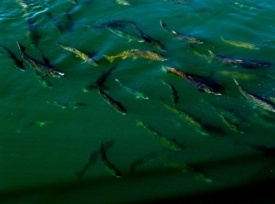
Fights over salmon have raged for decades in the Pacific Northwest. Overfishing in the late 19th century, the proliferation of dams in Oregon and Washington in the 20th, and more recent ecological shifts have set tribes, conservationists and the fishing industry head to head over the diminishing resource.
By the end of the 21st century, though, there may be nothing left to fight about.
The waters off the coast of the Pacific Northwest are warming, particularly in the upper reaches where pelagic fish like salmon and capelin swim and feed. If that trend continues, it could push many species northward by an average of 30 kilometers per decade, according to research published this week in the journal Progress in Oceanography.
The corresponding reshuffling along the Pacific Coast—with species mixing in new ways and new habitats—will have consequences that, at present, are difficult to predict, according to the study's authors.
The study estimates that water temperatures up and down the West Coast could rise by 5 degrees Fahrenheit over the next 35 years, although year-to-year temperatures can be confounded by El Niño oscillations and other weather patterns. Cold-water species like salmon are particularly sensitive to minor temperature changes, according to Richard Brodeur, a scientist with the National Oceanic and Atmospheric Administration and a co-author of the report.
Five degrees "doesn't seem like much, but fish often have a very narrow temperature range," he said.
"Warming would affect [salmon's] ocean distribution as they grow," he said. While salmon feed in the ocean for most of their lives, they tend to return to the streams and rivers of their birth at the end of their life to spawn, he said. Migrating up the coast would force them to travel a greater distance to return to those waters.
A $150M industry for Wash.
And for the fisheries that depend on the salmon and its co-inhabitants of the sea, business may have to move farther north, as well. The economic value of commercial fishing in Washington state alone was around $150 million in 2006, according to a study commissioned by the Washington Department of Fish and Wildlife.
Other species that depend on salmon as a food source may have an even harder time adapting to the changes. Like salmon, sea lions and seabirds rear their young in seasonal rookeries and colonies, returning to the same spots year on year. With the fish they're accustomed to eating shifting out of their typical foraging ranges, they'll have to expend more energy and cover greater distances, the authors said.
In all, the reshuffling of species up and down the coast—from warm-water Humboldt squid to cold-dwelling salmon and eulachon—will mean new areas of competition and new winners and losers.
Warmer reaches of the ocean are typically characterized by greater diversity of species, while a few species tend to dominate in the north. Introducing new predators and prey into what were essentially monopolies for species like salmon and walleye will create new food chains, and it's not at all clear that species will have the time they need to adapt.
"This reshuffling of marine species across the whole biological community may lead to declines in the beneficial functions of marine and coastal ecosystems," said Tom Okey, a co-author of the study and a Pew fellow in marine conservation at the University of Victoria. "These declines may occur much more rapidly and in more surprising ways than our expected changes in species alone."



